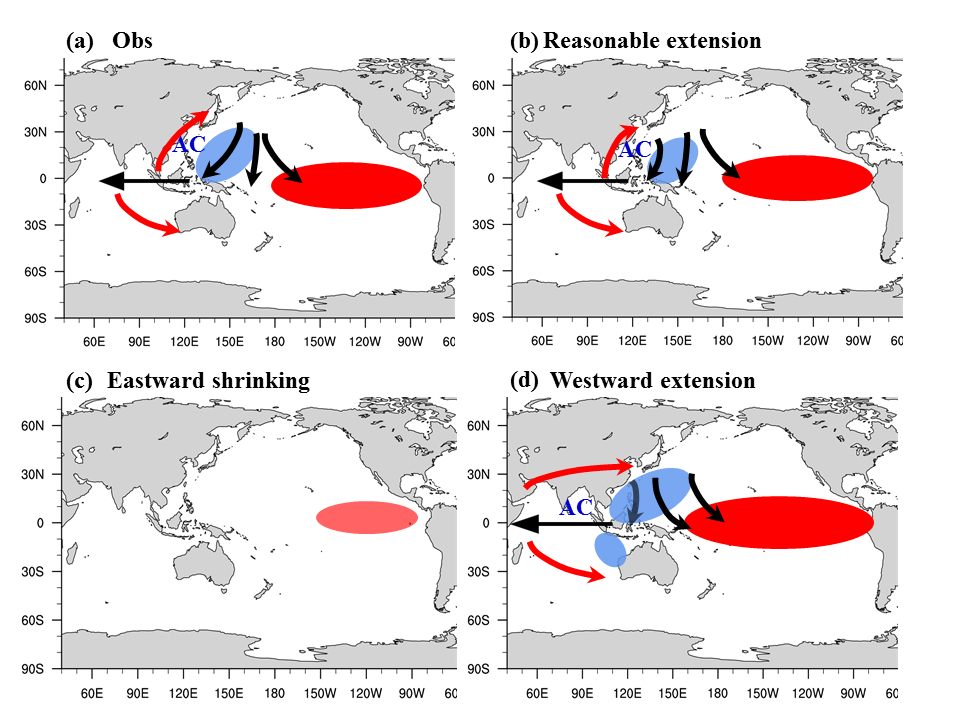ENSO—East Asian Winter Monsoon Relationship Depends on the ENSO's properties
Date:2015-03-30
As one of the most significant and powerful mid-latitude circulation systems, the East Asian winter monsoon (EAWM) dominates the wintertime climate of East Asia, leading to cold surges, snowstorms and freezing weathers as what happened to Southern China in early 2008. Meanwhile, it interacts intensely with the tropics, especially with the El Nino-Southern Oscillation (ENSO). In El Nino winters, the EAWM and the ENSO are closely linked to each other via an anomalous lower-tropospheric anticyclone around the Philippine Sea. The reproducibility of this EAWM-ENSO linkage in climate models is not only a crucial indicator to evaluate the performance of models, but also the basis for selecting models for the climate projection of the EAWM.
A research team from the Center for Monsoon System Research at Institute of Atmospheric Physics evaluated the performance of climate models in reproducing the climatology and interannual variability of the EAWM as well as the EAWM-ENSO linkage on the basis of the phase 5 of the Coupled Model Intercomparison Project (CMIP5).
Their investigation suggests that the current CMIP5 models can generally reproduce the climatology and interannual variability of the EAWM well, but are somewhat weak in reproducing the tropical-extratropical interactions associated with the EAWM. Specifically, the EAWM-ENSO linkage in models depends heavily on the simulation of ENSO properties. An eastward shrinking of ENSO’s sea surface temperature (SST) pattern leads to quite weak circulation and climatic responses over the East Asian-Western Pacific regions in the models. On the contrary, a westward expansion of the SST pattern shifts the atmospheric response too far west, and the resultant precipitation anomalies and lower-tropospheric atmospheric Rossby wave responses both extend unrealistically into the Indian Ocean. All these lead to unrealistic climatic impacts of ENSO over the East Asian-Western Pacific regions.
In contrast to the above two cases, a reasonable longitudinal extension of ENSO’s SST pattern corresponds to better ENSO teleconnections over the EAWP regions. Nevertheless, the atmospheric responses over the western Pacific are still located farther west than observed, implying a common bias of CMIP5 models. In this case, a larger amplitude of ENSO variability to some extent helps to reduce model biases and facilitate better climatic responses to ENSO in the East Asian-Western Pacific regions.
This finding is instrumental to understanding the mechanism through which ENSO influences the wintertime East Asia-Western Pacific climate. It could also serve as a reference to evaluate performance of climate models and to help improve climate prediction with numerical models.
The results are published in Journal of Climate.

Figure 1. The surbub of Leiyang City, Hunan Province in January 2008. (Photo from Wikipedia taken by Baycrest)

Figure 2. The ENSO-related pattern of sea surface temperature (SST) and lower tropospheric atmospheric circulation in (a) observations, model group with the simulated ENSO’s SST being located (b) similar to the observation, (c) eastward than the observation, and (d) westward than the observations.
Citation:
Gong, H., L. Wang, W. Chen, R. Wu, K. Wei, and X. Cui, 2014: The Climatology and Interannual Variability of the East Asian Winter Monsoon in CMIP5 Models. Journal of Climate, 27, 1659-1678. URL: http://journals.ametsoc.org/doi/abs/10.1175/JCLI-D-13-00039.1
Gong, H., L. Wang, W. Chen, D. Nath, G. Huang, and W. Tao, 2015: Diverse Influences of ENSO on the East Asian–Western Pacific Winter Climate Tied to Different ENSO Properties in CMIP5 Models. Journal of Climate, 28, 2187-2202. URL: http://journals.ametsoc.org/doi/abs/10.1175/JCLI-D-14-00405.1
Contact: Dr. WANG Lin, wanglin@mail.iap.ac.cn
